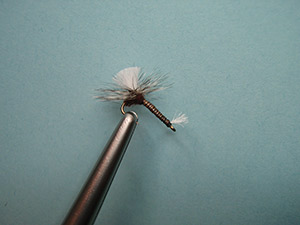REVERSE MIDGE EMERGER
JIM SCHOLLMEYER AND TED LEESON
This reverse style can be used for a variety of emerger types. It presents a clear and uncluttered profile of the body and shuck of the insect by placing the hook bend and spear at the head of the fly. Leave your tippet ungreased so that the hook shank will sink.PATTERN
HOOK – TMC101 – Mustad 3366 or other ring- eye, dry fly hook, #12 - #16
THREAD – Black 8/0
WING - White poly yarn
HACKLE – Grizzly
THORAX – Brown superfine dubbing
ABDOMEN – Stripped peacock quill (herl)
SHUCK - White antronHOW TO TIE
- Debarb hook – Mount the hook in the vise with the eyelet pointing down a little bit so you can tie the wing on. Start your thread about three eyelets from the eye of the hook and lay a thread base all the way into the bend of the hook (about 1/3 of the way). Cut a 3 inch length of poly yarn, then pull the yarn in half to make two wings but you may need to adjust the thickness according to the size of the hook. Next tie in the poly yarn by folding it over the thread and moving it to the top of the bend of the hook (from the back side and moving it to the top) make two or three wraps to hold it down. Then post it by making some wraps real close to the base of the wing (poly yarn), keep real close wraps and go up the wing just enough to put your hackle in ( about 4 or 5 wraps of hackle) then back down to the base (not to tight going up the wing but tighter going down).
- Prepare a hackle feather that is about one and a half the size of the hook gap and mount it at an angle just in front of the base (butt side at base of wing) facing the rear of the hook tying it to the front side of the wing then wrapping the bare shank of the feather up the wing and ending where you stopped your posting (this stiffens the post a little more), then wrap downward keeping close wraps each way. You should have the feather standing up right next to the wing. Do not wrap the feather yet.
- Dub a thorax without wax (dry)( using the superfine dubbing) a little behind the wing (about one eyelet) and in front of the wing (about 2 to 3 eyelets).
- With your fingers or hackle pliers wrap the hackle around the wing base (posting) about 4 or 5 wraps downward will do, then tie of in front of your thorax and clip the tag off.
- Re-mount the hook to a normal position then bring your thread forward to about one and a half eyelets from the eye and mount a sparse length of antron yarn for the shuck. Don’t worry about the length we will trim it after we are done. Now use the antron yarn to help you lay down a thread base over the antron and end it just in front of your thorax (dubbing), clip off tag end of yarn.
- Now select a long peacock herl from a sword as they are a little easier to work with. Using a pencil eraser gently rub the herl stem to remove the fibers , go easy cause we need the stem in one piece. Tie in the herl by the butt end, right in front of the thorax and wrap your thread forward and stop just in front of the shuck (antron yarn), Now you can use your hackle pliers or your fingers to wrap the herl forward keeping close wraps and even slightly over lapping each turn and end the wraps just in front of the shuck, Tie off, clip tag end, make a small head in front of the shuck and whip finish.
- Use a dubbing needle to apply a drop of head cement to the body for durability. Clip the wing post and the shuck to ½ the hook gap in length.


